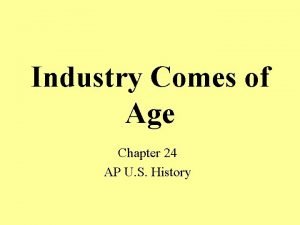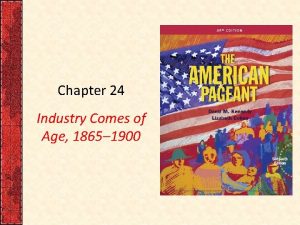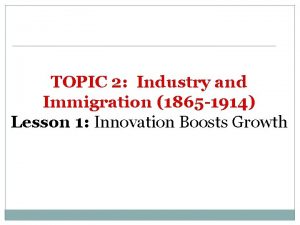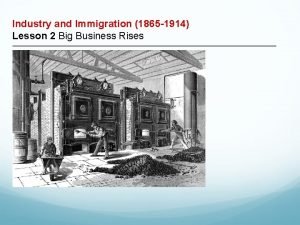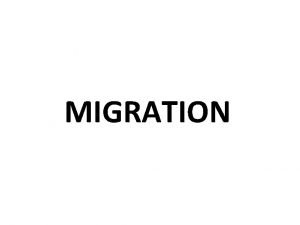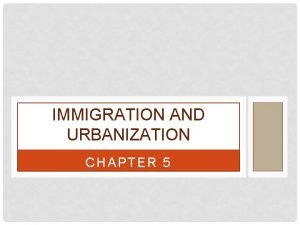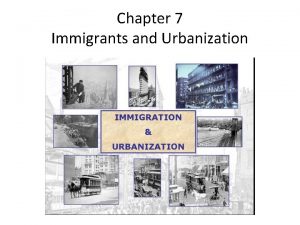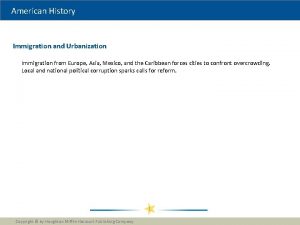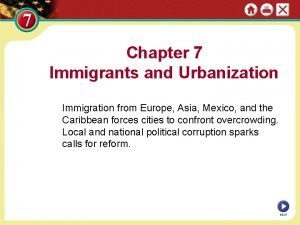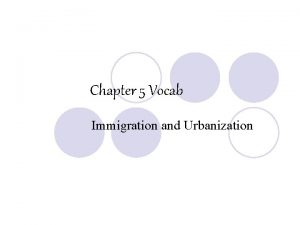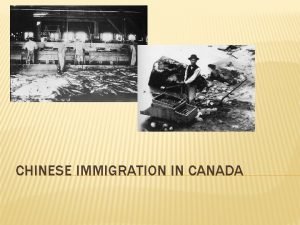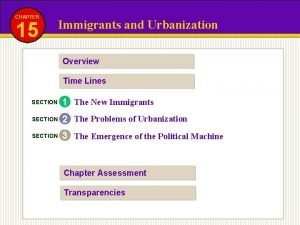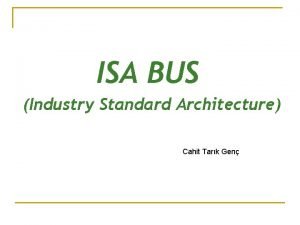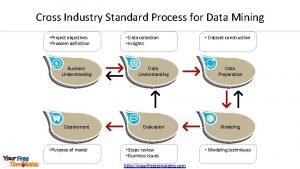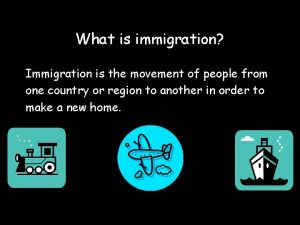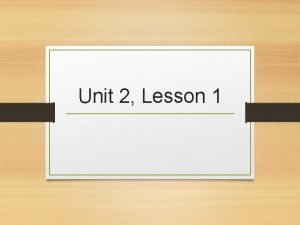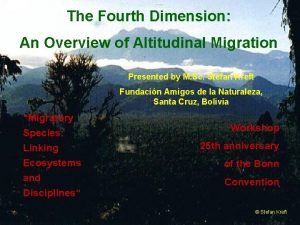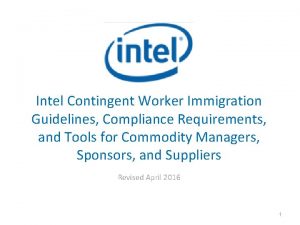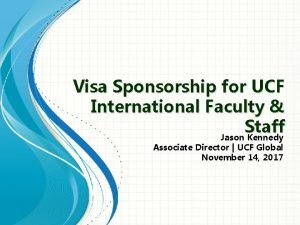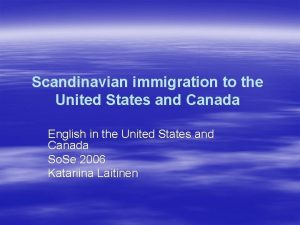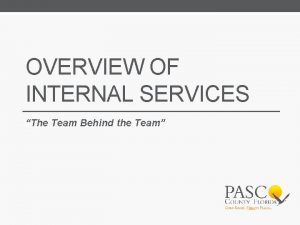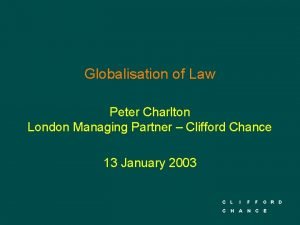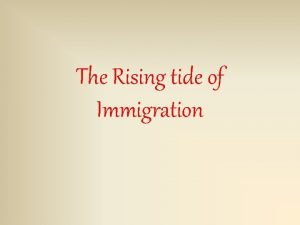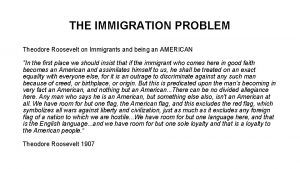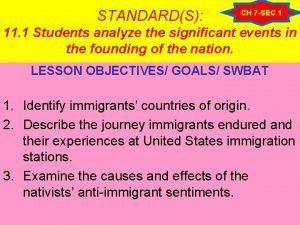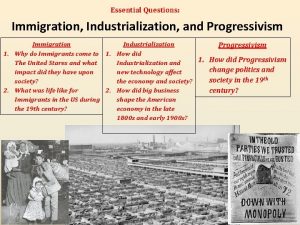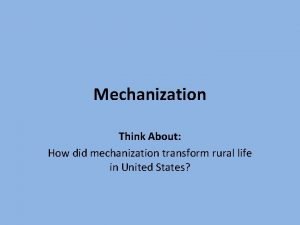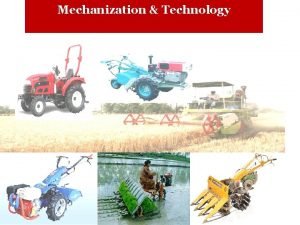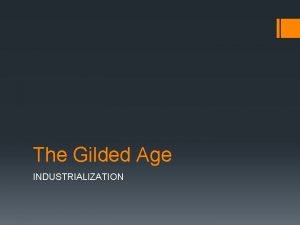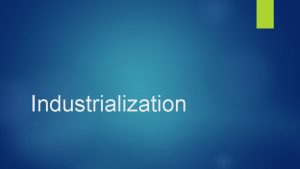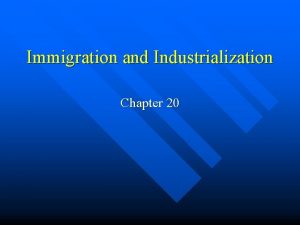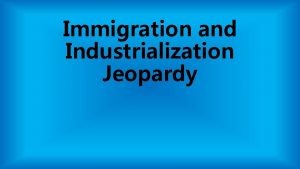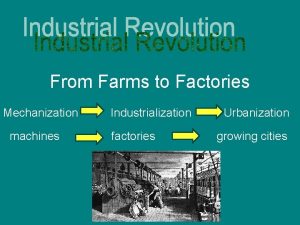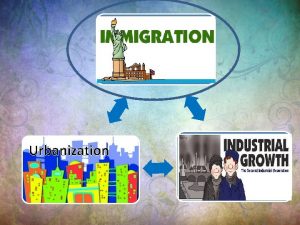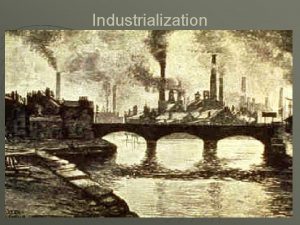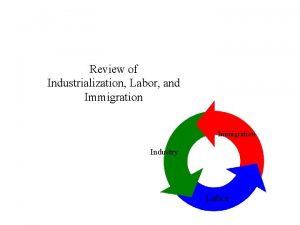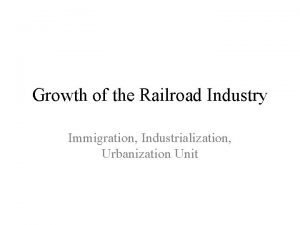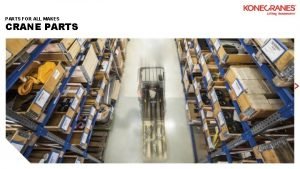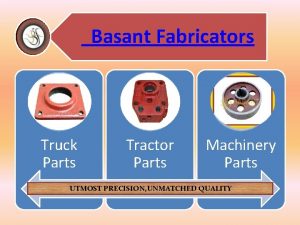Industrialization and Immigration Industry and Mechanization Standard parts






































- Slides: 38

Industrialization and Immigration

Industry and Mechanization • Standard parts • Mass production • Routine labor • Low wages • Technology

Child Labor • Factory hours were long and rarely paid much • Often all members of a family would have to work including very young children • Shifts were usually 10 to 14 hours and the children were paid around 30 to 75 cents a day • Many children were injured at work, losing limbs or contracting disease

Newsies

Factory Workers

Boy Coal Miners

Boy Coal Miners

Coal Shifters

Bowling Pin Setters

Triangle Shirtwaist Fire • A fire broke out in a shirt factory where women worked • Factory managers would lock the doors to keep the women from going out on breaks • Someone put a cigarette in a trash can where it caught on fire and burned down the whole building • Women jumped to their deaths rather than burn


Corporations • Andrew Carnegie -$310 Bil U. S. Steel (1870 s) • John D. Rockefeller -$340 Bil Standard Oil (1880 s) • J. P. Morgan -$38 Bil Finance, Railroad, U. S. Steel (1900 s)

Standard Oil

Railroad 1870 s

Railroad 1890 s

Social Darwinism and Laissez Faire • Theory of capitalism • “Free markets” = no government intervention • Consumer demand • Competition creates innovation and keeps prices low

Muckrakers • Upton Sinclair was an author who wrote the book The Jungle • The purpose of The Jungle was to show Americans the terrible working conditions of the workers in the meat packaging plants • “I aimed at the public’s heart, and by accident I hit it in the stomach” • This kind of writing became known as “muckraking”

Inventions • Bessemer Process – creates stronger steel • Pressure sealed tin cans • Alternating currents – Nikola Tesla • Technology begins to replace workers


Urbanization • Manufacturing brought people into the cities • Industrialization = Growth in cities • Technological advances: sewage, elevators, piped water, electricity, subways, electric streetcar (1888)

City Life • Fast growing • Few social services or regulations • Tenement buildings – horrible living conditions • Ethnically organized – usually by areas of town or neighborhoods

Tenement Housing

Immigration Why did people leave their homes? What were the costs and benefits of moving?

Ellis Island • By 1892, most immigrants were screened and processed at Ellis Island • By 1900, 50% of immigrants were from Eastern and Southern Europe

Angel Island

Industrialization Immigration

Why did they come to the U. S. ? • Political and religious freedom • Better economic opportunities • Gold Rush • Encouraging letters from relatives • U. S. Government advertisements • U. S. business recruitment

American Protective Association • • • Americans formed groups to opposed the “immigrant threat” Supported laws to restrict certain groups of immigrants. Immigrant groups: Chinese, Central and Southern Europeans. Why did Old Immigrants resent New Immigrants? “inferior stocks” Plot by European governments to unload their prisoners and mentally ill. Chinese worked for 5 years and left the U. S. with U. S. money Labor Unions hated immigrants because employers would hire “scab” labor to replace workers if they had a “Labor Strike” US Govt. restricts immigration with the following: Chinese Exclusion Act and Ellis Island



Chinese Exclusion Act • Resentment and discrimination against the Chinese. • First law to restrict immigration. • Taking away jobs from Nativists Chinese Exclusion Act 1


Chinese Exclusion Act • President Hayes vetoed this act and Congress would override it. • He would not be reelected. • Chinese immigration would be outlawed until the 1920’s.

Immigration and National Culture • Between 1870 – 1910 = 20 million immigrants came to America • Bringing with them new cultures (foods, religions, traditions, languages, etc. ) • Assimilation: We wanted immigrants to forget their old way of life and become AMERICANS. • We even offered Americanization schools teaching English and American Culture

Nativism



Closure • Give 3 examples of Industrialization and Mechanization. • Who were the big three corporate leaders? What were they each the leader of? • What effect did industrialization have on cities? • What were the two ports immigrants came through? • What is assimilation? • Write a paragraph explaining the Nativist political cartoon.
 Mechanization in a sentence
Mechanization in a sentence Miracles of mechanization
Miracles of mechanization Miracles of mechanization
Miracles of mechanization Industry and immigration lesson 1 innovation boosts growth
Industry and immigration lesson 1 innovation boosts growth Lesson 5 a nation of cities
Lesson 5 a nation of cities Industry and immigration lesson 2 big business rises
Industry and immigration lesson 2 big business rises Difference between immigration and emigration
Difference between immigration and emigration Chapter 5 immigration and urbanization
Chapter 5 immigration and urbanization Chapter 7 building vocabulary immigration and urbanization
Chapter 7 building vocabulary immigration and urbanization Chapter 7 building vocabulary immigration and urbanization
Chapter 7 building vocabulary immigration and urbanization Immigration and urbanization new technologies lesson 4
Immigration and urbanization new technologies lesson 4 Chapter 7 building vocabulary immigration and urbanization
Chapter 7 building vocabulary immigration and urbanization Chapter 5 immigration and urbanization
Chapter 5 immigration and urbanization Chinese immigration to canada push and pull factors
Chinese immigration to canada push and pull factors Chapter 15 building vocabulary immigration and urbanization
Chapter 15 building vocabulary immigration and urbanization Isa bus architecture
Isa bus architecture Semma
Semma What is immigration
What is immigration What is immigration
What is immigration How did esperanza help marta during an immigration sweep
How did esperanza help marta during an immigration sweep Fourth dimension immigration
Fourth dimension immigration Brain drain ap human geography definition
Brain drain ap human geography definition Emmigration
Emmigration Contingent workforce compliance
Contingent workforce compliance This is why people migrate aj+
This is why people migrate aj+ Http://teacher.scholastic.com/activities/immigration/tour/
Http://teacher.scholastic.com/activities/immigration/tour/ Klasko immigration law partners llp
Klasko immigration law partners llp European immigration to texas
European immigration to texas Ucf global immigration advisor
Ucf global immigration advisor How many states canada
How many states canada Jennie ellis australia immigration
Jennie ellis australia immigration Italian immigration to scotland
Italian immigration to scotland Frank & delaney immigration law, llc
Frank & delaney immigration law, llc Internal services
Internal services Immigration lawyers charlton
Immigration lawyers charlton What is this
What is this Teddy roosevelt on immigration
Teddy roosevelt on immigration European immigration
European immigration Immigration
Immigration

